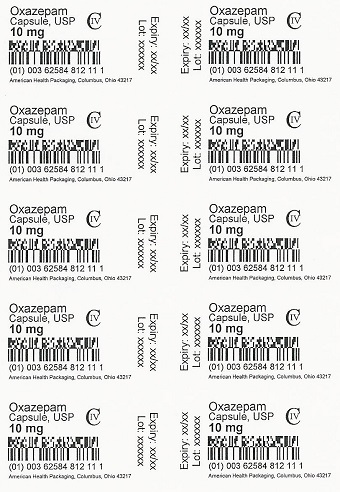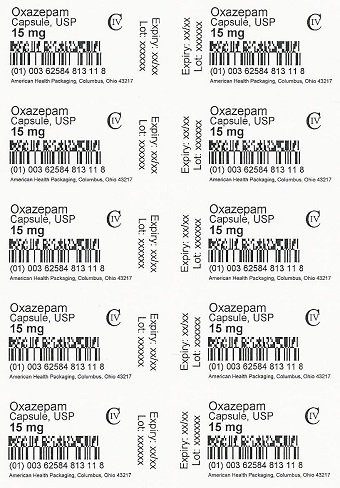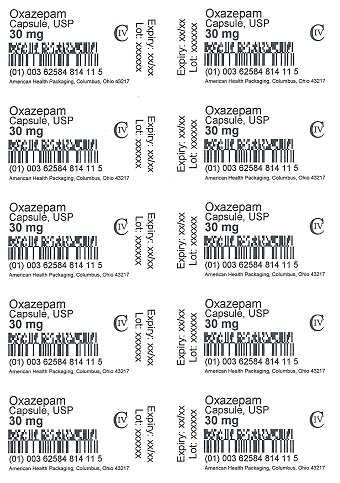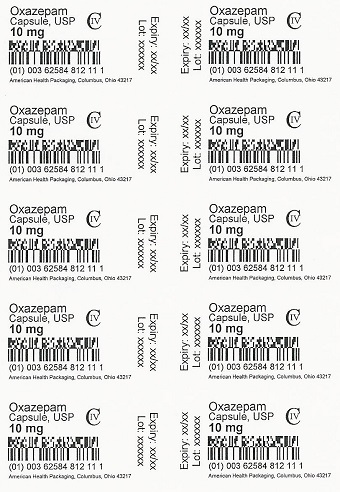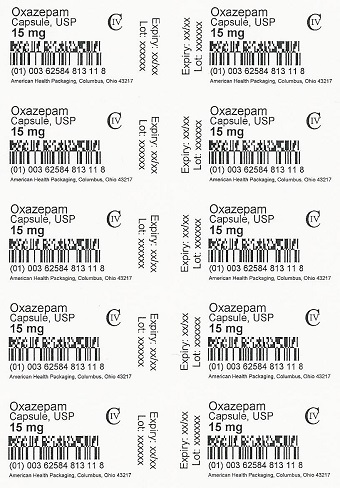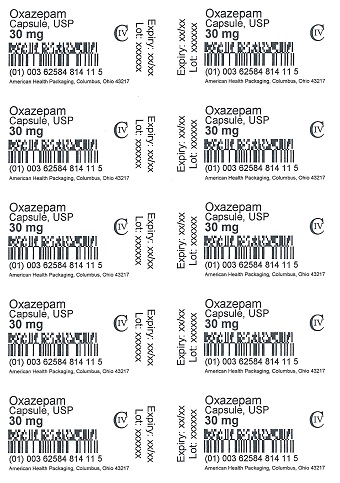Label: OXAZEPAM capsule, gelatin coated
-
NDC Code(s):
62584-812-01,
62584-812-11,
62584-813-01,
62584-813-11, view more62584-814-01, 62584-814-11
- Packager: American Health Packaging
- This is a repackaged label.
- Source NDC Code(s): 0228-2067, 0228-2069, 0228-2073
- Category: HUMAN PRESCRIPTION DRUG LABEL
- DEA Schedule: CIV
- Marketing Status: Abbreviated New Drug Application
Drug Label Information
Updated November 14, 2024
If you are a consumer or patient please visit this version.
- Download DRUG LABEL INFO: PDF XML
- Medication Guide: HTML
- Official Label (Printer Friendly)
- SPL UNCLASSIFIED SECTION
-
BOXED WARNING
(What is this?)
WARNING: RISKS FROM CONCOMITANT USE WITH OPIOIDS; ABUSE, MISUSE, AND ADDICTION; and DEPENDENCE AND WITHDRAWAL REACTIONS
- Concomitant use of benzodiazepines and opioids may result in profound sedation, respiratory depression, coma, and death.
- Reserve concomitant prescribing of these drugs for use in patients for whom alternative treatment options are inadequate.
- Limit dosages and durations to the minimum required.
- Follow patients for signs and symptoms of respiratory depression and sedation [see WARNINGSand PRECAUTIONS] .
- The use of benzodiazepines, including oxazepam, exposes users to risks of abuse, misuse, and addiction, which can lead to overdose or death. Abuse and misuse of benzodiazepines commonly involve concomitant use of other medications, alcohol, and/or illicit substances, which is associated with an increased frequency of serious adverse outcomes. Before prescribing oxazepam and throughout treatment, assess each patient’s risk for abuse, misuse, and addiction [see WARNINGS] .
- The continued use of benzodiazepines, including oxazepam, may lead to clinically significant physical dependence. The risks of dependence and withdrawal increase with longer treatment duration and higher daily dose. Abrupt discontinuation or rapid dosage reduction of oxazepam after continued use may precipitate acute withdrawal reactions, which can be life-threatening. To reduce the risk of withdrawal reactions, use a gradual taper to discontinue oxazepam or reduce the dosage [see DOSAGE AND ADMINISTRATIONand WARNINGS].
-
DESCRIPTION
Oxazepam, USP is the first of a chemical series of compounds known as the 3-hydroxybenzodiazepinones. A therapeutic agent providing versatility and flexibility in control of common emotional disturbances, this product exerts prompt action in a wide variety of disorders associated with anxiety, tension, agitation, and irritability, and anxiety associated with depression. In tolerance and toxicity studies on several animal species, this product reveals significantly greater safety factors than related compounds (chlordiazepoxide and diazepam) and manifests a wide separation of effective doses and doses inducing side effects.
Oxazepam capsules, USP contain 10 mg, 15 mg or 30 mg oxazepam, USP and the following inactive ingredients: corn starch, croscarmellose sodium, hypromellose 2910, lactose monohydrate, magnesium stearate, and sodium lauryl sulfate. The capsule shells contain gelatin, methylparaben, propylparaben, and titanium dioxide. In addition, the 10 mg capsule shells contain D&C Red No. 28 and FD&C Red No. 40, the 15 mg capsule shells contain D&C Yellow No. 10 and FD&C Red No. 40, and the 30 mg capsule shells contain D&C Red No. 28, FD&C Blue No. 1, and FD&C Red No. 40. The imprinting ink, for the 10 mg and 15 mg capsules, contains black iron oxide, FD&C Blue No. 1 Brilliant Blue FCF Aluminum Lake, FD&C Blue No. 2 Indigo Carmine Aluminum Lake, FD&C Red No. 40 Allura Red AC Aluminum Lake, D&C Yellow No. 10 Aluminum Lake, shellac, and may also contain propylene glycol. The imprinting ink, for the 30 mg capsules, contains ethyl acetate, FD&C Blue No. 1 Aluminum Lake, and shellac.
Oxazepam, USP is 7-chloro-1,3-dihydro-3-hydroxy-5-phenyl-2 H-1,4-benzodiazepin-2-one. A white crystalline powder with a molecular weight of 286 .72, its structural formula is as follows:
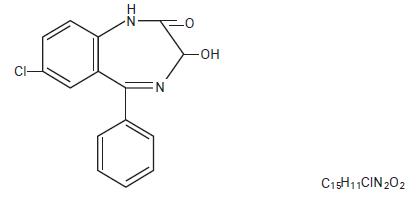
-
CLINICAL PHARMACOLOGY
Pharmacokinetic testing in 12 volunteers demonstrated that a single 30 mg dose of a capsule, tablet or suspension will result in an equivalent extent of absorption. For the capsule and tablet, peak plasma levels averaged 450 mg/mL and were observed to occur about 3 hours after dosing. The mean elimination half-life for oxazepam was approximately 8.2 hours (range 5.7 to 10.9 hours).
This product has a single, major inactive metabolite in man, a glucuronide excreted in the urine.
Age (less than 80 years old) does not appear to have a clinically significant effect on oxazepam kinetics. A statistically significant increase in elimination half-life in the very elderly (greater than 80 years of age) as compared to younger subjects has been reported, due to a 30% increase in volume of distribution, as well as a 50% reduction in unbound clearance of oxazepam in the very elderly [see PRECAUTIONS: Geriatric Use].
-
INDICATIONS
Oxazepam capsules are indicated for the management of anxiety disorders or for the short-term relief of the symptoms of anxiety. Anxiety or tension associated with the stress of everyday life usually does not require treatment with an anxiolytic.
Anxiety associated with depression is also responsive to oxazepam therapy.
This product has been found particularly useful in the management of anxiety, tension, agitation and irritability in older patients.
Alcoholics with acute tremulousness, inebriation, or with anxiety associated with alcohol withdrawal are responsive to therapy.
The effectiveness of oxazepam in long-term use, that is, more than 4 months, has not been assessed by systematic clinical studies. The physician should periodically reassess the usefulness of the drug for the individual patient.
- CONTRAINDICATIONS
-
WARNINGS
Risks from Concomitant Use with Opioids: Concomitant use of benzodiazepines, including oxazepam, and opioids may result in profound sedation, respiratory depression, coma, and death. Because of these risks, reserve concomitant prescribing of these drugs in patients for whom alternative treatment options are inadequate.
Observational studies have demonstrated that concomitant use of opioid analgesics and benzodiazepines increases the risk of drug-related mortality compared to use of opioids alone. If a decision is made to prescribe oxazepam concomitantly with opioids, prescribe the lowest effective dosages and minimum durations of concomitant use, and follow patients closely for signs and symptoms of respiratory depression and sedation. In patients already receiving an opioid analgesic, prescribe a lower initial dose of oxazepam than indicated in the absence of an opioid and titrate based on clinical response. If an opioid is initiated in a patient already taking oxazepam, prescribe a lower initial dose of the opioid and titrate based upon clinical response.
Advise both patients and caregivers about the risks of respiratory depression and sedation when oxazepam is used with opioids. Advise patients not to drive or operate heavy machinery until the effects of concomitant use with the opioid have been determined [see PRECAUTIONS: Drug Interactions].
Abuse, Misuse, and Addiction: The use of benzodiazepines, including oxazepam, exposes users to the risks of abuse, misuse, and addiction, which can lead to overdose or death. Abuse and misuse of benzodiazepines often (but not always) involve the use of doses greater than the maximum recommended dosage and commonly involve concomitant use of other medications, alcohol, and/or illicit substances, which is associated with an increased frequency of serious adverse outcomes, including respiratory depression, overdose, or death [see DRUG ABUSE AND DEPENDENCE: Abuse] .
Before prescribing oxazepam and throughout treatment, assess each patient’s risk for abuse, misuse, and addiction (e.g., using a standardized screening tool). Use of oxazepam, particularly in patients at elevated risk, necessitates counseling about the risks and proper use of oxazepam along with monitoring for signs and symptoms of abuse, misuse, and addiction. Prescribe the lowest effective dosage; avoid or minimize concomitant use of CNS depressants and other substances associated with abuse, misuse, and addiction (e.g., opioid analgesics, stimulants); and advise patients on the proper disposal of unused drug. If a substance use disorder is suspected, evaluate the patient and institute (or refer them for) early treatment, as appropriate.
Dependence and Withdrawal Reactions:To reduce the risk of withdrawal reactions, use a gradual taper to discontinue oxazepam or reduce the dosage (a patient-specific plan should be used to taper the dose) [see DOSAGE AND ADMINISTRATION: Discontinuation or Dosage Reduction of Oxazepam] .
Patients at an increased risk of withdrawal adverse reactions after benzodiazepine discontinuation or rapid dosage reduction include those who take higher dosages, and those who have had longer durations of use.
Acute Withdrawal Reactions
The continued use of benzodiazepines, including oxazepam, may lead to clinically significant physical dependence. Abrupt discontinuation or rapid dosage reduction of oxazepam after continued use, or administration of flumazenil (a benzodiazepine antagonist) may precipitate acute withdrawal reactions, which can be life-threatening (e.g., seizures) [see DRUG ABUSE AND DEPENDENCE: Dependence].Protracted Withdrawal Syndrome
In some cases, benzodiazepine users have developed a protracted withdrawal syndrome with withdrawal symptoms lasting weeks to more than 12 months [see DRUG ABUSE AND DEPENDENCE: Dependence] .As with other CNS-acting drugs, patients should be cautioned against driving automobiles or operating dangerous machinery until it is known that they do not become drowsy or dizzy on oxazepam therapy.
Patients should be warned that the effects of alcohol or other CNS-depressant drugs may be additive to those of Oxazepam, possibly requiring adjustment of dosage or elimination of such agents.
Neonatal Sedation and Withdrawal Syndrome
Use of oxazepam late in pregnancy can result in sedation (respiratory depression, lethargy, hypotonia) and/or withdrawal symptoms (hyperreflexia, irritability, restlessness, tremors, inconsolable crying, and feeding difficulties) in the neonate [see PRECAUTIONS, Pregnancy]. Monitor neonates exposed to oxazepam during pregnancy or labor for signs of sedation and monitor neonates exposed to oxazepam during pregnancy for signs of withdrawal; manage these neonates accordingly. -
PRECAUTIONS
General
Although hypotension has occurred only rarely, oxazepam should be administered with caution to patients in whom a drop in blood pressure might lead to cardiac complications. This is particularly true in the elderly patient.
Information for Patients
Advise the patient to read the FDA-approved patient labeling (Medication Guide).
Risks from Concomitant Use with Opioids
Advise both patients and caregivers about the risks of potentially fatal respiratory depression and sedation when oxazepam is used with opioids and not to use such drugs concomitantly unless supervised by a health care provider. Advise patients not to drive or operate heavy machinery until the effects of concomitant use with the opioid have been determined [see WARNINGS: Risks from Concomitant Use with Opioidsand PRECAUTIONS: Drug Interactions] .Abuse, Misuse, and Addiction
Inform patients that the use of oxazepam, even at recommended dosages, exposes users to risks of abuse, misuse, and addiction, which can lead to overdose and death, especially when used in combination with other medications (e.g., opioid analgesics), alcohol, and/or illicit substances. Inform patients about the signs and symptoms of benzodiazepine abuse, misuse, and addiction; to seek medical help if they develop these signs and/or symptoms; and on the proper disposal of unused drug [see WARNINGS: Abuse, Misuse, and Addictionand DRUG ABUSE AND DEPENDENCE] .Withdrawal Reactions
Inform patients that the continued use of oxazepam may lead to clinically significant physical dependence and that abrupt discontinuation or rapid dosage reduction of oxazepam may precipitate acute withdrawal reactions, which can be life-threatening. Inform patients that in some cases, patients taking benzodiazepines have developed a protracted withdrawal syndrome with withdrawal symptoms lasting weeks to more than 12 months. Instruct patients that discontinuation or dosage reduction of oxazepam may require a slow taper [see WARNINGS: Dependence and Withdrawal Reactionsand DRUG ABUSE AND DEPENDENCE] .Pregnancy
Advise pregnant females that use of oxazepam late in pregnancy can result in sedation (respiratory depression, lethargy, hypotonia) and/or withdrawal symptoms (hyperreflexia, irritability, restlessness, tremors, inconsolable crying, and feeding difficulties) in newborns [see Warnings, Neonatal Sedation and Withdrawal Syndromeand Precautions, Pregnancy] . Instruct patients to inform their healthcare provider if they are pregnant.Advise patients that there is a pregnancy exposure registry that monitors pregnancy outcomes in women exposed to oxazepam during pregnancy [see Precautions, Pregnancy].
Nursing
Instruct patients to notify their healthcare provider if they are breastfeeding or intend to breastfeed. Instruct breastfeeding patients using oxazepam to monitor infants for excessive sedation, poor feeding and poor weight gain, and to seek medical attention if they notice these signs [see Precautions, Nursing Mothers].Drug Interactions
The concomitant use of benzodiazepines and opioids increases the risk of respiratory depression because of actions at different receptor sites in the CNS that control respiration. Benzodiazepines interact at GABAA sites and opioids interact primarily at mu receptors. When benzodiazepines and opioids are combined, the potential for benzodiazepines to significantly worsen opioid-related respiratory depression exists. Limit dosage and duration of concomitant use of benzodiazepines and opioids, and monitor patients closely for respiratory depression and sedation.
Pregnancy
Pregnancy Exposure Registry
There is a pregnancy registry that monitors pregnancy outcomes in women exposed to psychiatric medications, including oxazepam during pregnancy. Healthcare providers are encouraged to register patients by calling the National Pregnancy Registry for Psychiatric Medications at 1-866-961-2388 or visiting online at https://womensmentalhealth.org/pregnancyregistry/.Risk Summary
Neonates born to mothers using benzodiazepines late in pregnancy have been reported to experience symptoms of sedation and/or neonatal withdrawal [see WARNINGS, Neonatal Sedation and Withdrawal Syndrome and PRECAUTIONS: Clinical Considerations].Available data from published observational studies of pregnant women exposed to benzodiazepines do not report a clear association with benzodiazepines and major birth defects [see Data].
The estimated background risk of major birth defects and miscarriage for the indicated population is unknown. All pregnancies have a background risk of birth defect, loss, or other adverse outcomes. In the U.S. general population, the estimated risk of major birth defects and of miscarriage in clinically recognized pregnancies is 2% to 4% and 15% to 20%, respectively.
Clinical Considerations
Fetal/Neonatal Adverse Reactions
Benzodiazepines cross the placenta and may produce respiratory depression, hypotonia and sedation in neonates. Monitor neonates exposed to oxazepam during pregnancy or labor for signs of sedation, respiratory depression, hypotonia, and feeding problems. Monitor neonates exposed to oxazepam during pregnancy for signs of withdrawal. Manage these neonates accordingly [see WARNINGS, Neonatal Sedation and Withdrawal Syndrome].Data
Human Data
Published data from observational studies on the use of benzodiazepines during pregnancy do not report a clear association with benzodiazepines and major birth defects. Although early studies reported an increased risk of congenital malformations with diazepam and chlordiazepoxide, there was no consistent pattern noted. In addition, the majority of more recent case-control and cohort studies of benzodiazepine use during pregnancy, which were adjusted for confounding exposures to alcohol, tobacco and other medications, have not confirmed these findings.Animal Data
Reproductive studies in animals were performed in mice, rats, and two strains of rabbits. Occasional anomalies (reduction of tarsals, tibia, metatarsals, malrotated limbs, gastroschisis, malformed skull, and microphthalmia) were seen in drug-treated rabbits without relationship to dosage. Although all of these anomalies were not present in the concurrent control group, they have been reported to occur randomly in historical controls. At doses of 40 mg/kg and higher, there was evidence of fetal resorption and increased fetal loss in rabbits which was not seen at lower doses.Nursing Mothers
Risk Summary
Oxazepam is present in breast milk. There are reports of sedation, poor feeding and poor weight gain in infants exposed to benzodiazepines through breast milk [see Clinical Considerations]. The effects of oxazepam on milk production are unknown. The developmental and health benefits of breastfeeding should be considered along with the mother’s clinical need for oxazepam and any potential adverse effects on the breastfed infant from oxazepam or from the underlying maternal condition.Clinical Considerations
Infants exposed to oxazepam through breast milk should be monitored for sedation, poor feeding and poor weight gain.Pediatric Use
Safety and effectiveness in pediatric patients under 6 years of age have not been established. Absolute dosage for pediatric patients 6 to 12 years of age is not established.
Geriatric Use
Clinical studies of oxazepam were not adequate to determine whether subjects aged 65 and over respond differently than younger subjects. Age (less than 80 years old) does not appear to have a clinically significant effect on oxazepam kinetics [see CLINICAL PHARMACOLOGY].
Clinical circumstances, some of which may be more common in the elderly, such as hepatic or renal impairment, should be considered. Greater sensitivity of some older individuals to the effects of oxazepam (e.g., sedation, hypotension, paradoxical excitation) cannot be ruled out [see PRECAUTIONS: Generaland ADVERSE REACTIONS]. In general, dose selection for oxazepam for elderly patients should be cautious, usually starting at the lower end of the dosing range [see DOSAGE AND ADMINISTRATION] .
-
ADVERSE REACTIONS
The necessity for discontinuation of therapy due to undesirable effects has been rare. Transient mild drowsiness is commonly seen in the first few days of therapy. If it persists, the dosage should be reduced. In few instances, dizziness, vertigo, headache and rarely syncope have occurred either alone or together with drowsiness. Mild paradoxical reactions; i.e., excitement, stimulation of affect, have been reported in psychiatric patients; these reactions may be secondary to relief of anxiety and usually appear in the first two weeks of therapy.
Other side effects occurring during oxazepam therapy include rare instances of minor diffuse skin rashes - morbilliform, urticarial, and maculopapular, nausea, lethargy, edema, slurred speech, tremor, and altered libido. Such side effects have been infrequent and are generally controlled with reduction of dosage. A case of an extensive fixed drug eruption also has been reported.
Although rare, leukopenia and hepatic dysfunction including jaundice have been reported during therapy. Periodic blood counts and liver-function tests are advisable. Ataxia with oxazepam has been reported in rare instances and does not appear to be specifically related to dose or age.
Although the following side reactions have not as yet been reported with oxazepam, they have occurred with related compounds (chlordiazepoxide and diazepam): paradoxical excitation with severe rage reactions, hallucinations, menstrual irregularities, change in EEG pattern, blood dyscrasias including agranulocytosis, blurred vision, diplopia, incontinence, stupor, disorientation, fever and euphoria.
Transient amnesia or memory impairment has been reported in association with the use of benzodiazepines.
To report SUSPECTED ADVERSE EVENTS, contact Teva at 1-888-838-2872 or FDA at 1-800-FDA-1088 or http://www.fda.gov/medwatch for voluntary reporting of adverse reactions.
-
DRUG ABUSE AND DEPENDENCE
Controlled Substance
Oxazepam is a schedule IV controlled substance.Abuse
Oxazepam is a benzodiazepine and a CNS depressant with a potential for abuse and addiction. Abuse is the intentional, nontherapeutic use of a drug, even once, for its desirable psychological or physiological effects. Misuse is the intentional use, for therapeutic purposes, of a drug by an individual in a way other than prescribed by a health care provider or for whom it was not prescribed. Drug addiction is a cluster of behavioral, cognitive, and physiological phenomena that may include a strong desire to take the drug, difficulties in controlling drug use (e.g., continuing drug use despite harmful consequences, giving a higher priority to drug use than other activities and obligations), and possible tolerance or physical dependence. Even taking benzodiazepines as prescribed may put patients at risk for abuse and misuse of their medication. Abuse and misuse may lead to addiction.Abuse and misuse of benzodiazepines often (but not always) involve the use of doses greater than the maximum recommended dosage and commonly involve concomitant use of other medications, alcohol, and/or illicit substances, which is associated with an increased frequency of serious adverse outcomes, including respiratory depression, overdose, or death. Benzodiazepines are often sought by individuals who abuse drugs and other substances, and by individuals with addictive disorders [see WARNINGS: Abuse, Misuse, and Addiction] .
The following adverse reactions have occurred with benzodiazepine abuse and/or misuse: abdominal pain, amnesia, anorexia, anxiety, aggression, ataxia, blurred vision, confusion, depression, disinhibition, disorientation, dizziness, euphoria, impaired concentration and memory, indigestion, irritability, muscle pain, slurred speech, tremors, and vertigo.
The following severe adverse reactions have occurred with benzodiazepine abuse and/or misuse: delirium, paranoia, suicidal ideation and behavior, seizures, coma, breathing difficulty, and death. Death is more often associated with polysubstance use (especially benzodiazepines with other CNS depressants such as opioids and alcohol).
Dependence
Physical Dependence
Oxazepam may produce physical dependence from continued therapy. Physical dependence is a state that develops as a result of physiological adaptation in response to repeated drug use, manifested by withdrawal signs and symptoms after abrupt discontinuation or a significant dose reduction of a drug. Abrupt discontinuation or rapid dosage reduction of benzodiazepines or administration of flumazenil, a benzodiazepine antagonist, may precipitate acute withdrawal reactions, including seizures, which can be life-threatening. Patients at an increased risk of withdrawal adverse reactions after benzodiazepine discontinuation or rapid dosage reduction include those who take higher dosages (i.e., higher and/or more frequent doses) and those who have had longer durations of use [see WARNINGS: Dependence and Withdrawal Reactions] .To reduce the risk of withdrawal reactions, use a gradual taper to discontinue oxazepam or reduce the dosage [see DOSAGE AND ADMINISTRATION: Discontinuation or Dosage Reduction of Oxazepamand WARNINGS: Dependence and Withdrawal Reactions] .
Acute Withdrawal Signs and Symptoms
Acute withdrawal signs and symptoms associated with benzodiazepines have included abnormal involuntary movements, anxiety, blurred vision, depersonalization, depression, derealization, dizziness, fatigue, gastrointestinal adverse reactions (e.g., nausea, vomiting, diarrhea, weight loss, decreased appetite), headache, hyperacusis, hypertension, irritability, insomnia, memory impairment, muscle pain and stiffness, panic attacks, photophobia, restlessness, tachycardia, and tremor. More severe acute withdrawal signs and symptoms, including life-threatening reactions, have included catatonia, convulsions, delirium tremens, depression, hallucinations, mania, psychosis, seizures, and suicidality.Protracted Withdrawal Syndrome
Protracted withdrawal syndrome associated with benzodiazepines is characterized by anxiety, cognitive impairment, depression, insomnia, formication, motor symptoms (e.g., weakness, tremor, muscle twitches), paresthesia, and tinnitus that persists beyond 4 to 6 weeks after initial benzodiazepine withdrawal. Protracted withdrawal symptoms may last weeks to more than 12 months. As a result, there may be difficulty in differentiating withdrawal symptoms from potential re-emergence or continuation of symptoms for which the benzodiazepine was being used.Tolerance
Tolerance to oxazepam may develop from continued therapy. Tolerance is a physiological state characterized by a reduced response to a drug after repeated administration (i.e., a higher dose of a drug is required to produce the same effect that was once obtained at a lower dose). Tolerance to the therapeutic effect of oxazepam may develop; however, little tolerance develops to the amnestic reactions and other cognitive impairments caused by benzodiazepines. -
OVERDOSAGE
Overdosage of benzodiazepines is characterized by central nervous system depression ranging from drowsiness to coma. In mild to moderate cases, symptoms can include drowsiness, confusion, dysarthria, lethargy, hypnotic state, diminished reflexes, ataxia, and hypotonia. Rarely, paradoxical or disinhibitory reactions (including agitation, irritability, impulsivity, violent behavior, confusion, restlessness, excitement, and talkativeness) may occur. In severe overdosage cases, patients may develop respiratory depression and coma. Overdosage of benzodiazepines in combination with other CNS depressants (including alcohol and opioids) may be fatal (see WARNINGS, Abuse, Misuse, and Addiction). Markedly abnormal (lowered or elevated) blood pressure, heart rate, or respiratory rate raise the concern that additional drugs and/or alcohol are involved in the overdosage.
In managing benzodiazepine overdosage, employ general supportive measures, including intravenous fluids and airway management. Flumazenil, a specific benzodiazepine receptor antagonist indicated for the complete or partial reversal of the sedative effects of benzodiazepines in the management of benzodiazepine overdosage, can lead to withdrawal and adverse reactions, including seizures, particularly in the context of mixed overdosage with drugs that increase seizure risk (e.g., tricyclic and tetracyclic antidepressants) and in patients with long-term benzodiazepine use and physical dependency. The risk of withdrawal seizures with flumazenil use may be increased in patients with epilepsy. Flumazenil is contraindicated in patients who have received a benzodiazepine for control of a potentially life-threatening condition (e.g., status epilepticus). If the decision is made to use flumazenil, it should be used as an adjunct to, not as a substitute for, supportive management of benzodiazepine overdosage. See the flumazenil injection Prescribing Information.
Consider contacting a poison center (1-800-222-1222), poisoncontrol.org, or a medical toxicologist for additional overdosage management recommendations.
-
DOSAGE AND ADMINISTRATION
Because of the flexibility of this product and the range of emotional disturbances responsive to it, dosage should be individualized for maximum beneficial effects.
Oxazepam
Usual Dose
Mild-to-moderate anxiety, with associated tension, irritability, agitation, or related symptoms of functional origin or secondary to organic disease.
10 to 15 mg, 3 or 4 times daily
Severe anxiety syndromes, agitation, or anxiety associated with depression.
15 to 30 mg, 3 or 4 times daily
Older patients with anxiety, tension, irritability and agitation.
Initial dosage: 10 mg, 3 times daily.
If necessary, increase cautiously to 15 mg, 3 or 4 times daily.Alcoholics with acute inebriation, tremulousness, or anxiety on withdrawal.
15 to 30 mg, 3 or 4 times daily
This product is not indicated in pediatric patients under 6 years of age. Absolute dosage for pediatric patients 6 to 12 years of age is not established.
Discontinuation or Dosage Reduction of Oxazepam
To reduce the risk of withdrawal reactions, use a gradual taper to discontinue oxazepam or reduce the dosage. If a patient develops withdrawal reactions, consider pausing the taper or increasing the dosage to the previous tapered dosage level. Subsequently decrease the dosage more slowly [see WARNINGS: Dependence and Withdrawal Reactionsand DRUG ABUSE AND DEPENDENCE: Dependence] . -
HOW SUPPLIED
Oxazepam capsules, USP are available as follows:
10 mg — Each pink opaque gelatin #4 capsule printed with and 067 in black ink on both cap and body contains 10 mg of Oxazepam, USP. Capsules are supplied in unit dose packages of 100 (10 x 10) NDC 62584-812-01.
and 067 in black ink on both cap and body contains 10 mg of Oxazepam, USP. Capsules are supplied in unit dose packages of 100 (10 x 10) NDC 62584-812-01.
15 mg — Each red opaque gelatin #4 capsule printed with
 and 069 in black ink on both cap and body contains 15 mg of Oxazepam, USP. Capsules are supplied in unit dose packages of 100 (10 x 10) NDC 62584-813-01.
and 069 in black ink on both cap and body contains 15 mg of Oxazepam, USP. Capsules are supplied in unit dose packages of 100 (10 x 10) NDC 62584-813-01.
30 mg — Each maroon opaque gelatin #4 capsule printed with
 and 073 in blue ink on both cap and body contains 30 mg of Oxazepam, USP. Capsules are supplied in unit dose packages of 100 (10 x 10) NDC 62584-814-01.
and 073 in blue ink on both cap and body contains 30 mg of Oxazepam, USP. Capsules are supplied in unit dose packages of 100 (10 x 10) NDC 62584-814-01.
Store at 25ºC (77ºF); excursions permitted to 15ºC to 30ºC (59ºF to 86ºF).
FOR YOUR PROTECTION: Do not use if blister is torn or broken.
-
ANIMAL PHARMACOLOGY AND TOXICOLOGY
In mice, oxazepam exerts an anticonvulsant (anti-pentylenetetrazol) activity at 50-percent-effective doses of about 0.6 mg/kg orally. (Such anticonvulsant activity of benzodiazepines correlates with their tranquilizing properties.) To produce ataxia (rotabar test) and sedation (abolition of spontaneous motor activity), the 50-percent-effective doses of this product are greater than 5 mg/kg orally. Thus, about ten times the therapeutic (anticonvulsant) dose must be given before ataxia ensues, indicating a wide separation of effective doses and doses inducing side effects.
In evaluation of antianxiety activity of compounds, conflict behavioral tests in rats differentiate continuous response for food in the presence of anxiety-provoking stress (shock) from drug-induced motor incoordination. This product shows significant separation of doses required to relieve anxiety and doses producing sedation or ataxia. Ataxia-producing doses exceed those of related CNS-acting drugs.
Acute oral LD 50 in mice is greater than 5000 mg/kg, compared to 800 mg/kg for a related compound (chlordiazepoxide).
Subacute toxicity studies in dogs for four weeks at 480 mg/kg daily showed no specific changes; at 960 mg/kg, two out of eight died with evidence of circulatory collapse. This wide margin of safety is significant compared to chlordiazepoxide HCl, which showed nonspecific changes in six dogs at 80 mg/kg. On chlordiazepoxide, two out of six died with evidence of circulatory collapse at 127 mg/kg, and six out of six died at 200 mg/kg daily. Chronic toxicity studies of oxazepam in dogs at 120 mg/kg/day for 52 weeks produced no toxic manifestation.
Fatty metamorphosis of the liver has been noted in six-week toxicity studies in rats given this product at 0.5% of the diet. Such accumulations of fat are considered reversible, as there is no liver necrosis or fibrosis. Breeding studies in rats through two successive litters did not produce fetal abnormality.
Oxazepam has not been adequately evaluated for mutagenic activity.
In a carcinogenicity study, oxazepam was administered with diet to rats for two years. Male rats receiving 30 times the maximum human dose showed a statistical increase, when compared to controls, in benign thyroid follicular cell tumors, testicular interstitial cell adenomas, and prostatic adenomas. An earlier published study reported that mice fed dietary dosages of 35 or 100 times the human daily dose of oxazepam for 9 months developed a dose-related increase in liver adenomas. 1 in an independent analysis of some of the microscopic slides from this mouse study, several of these tumors were classified as liver carcinomas. At this time, there is no evidence that clinical use of oxazepam is associated with tumors.
- REFERENCE
-
PACKAGING INFORMATION
American Health Packaging unit dose blisters (see How Supplied section) contain drug product from Teva Pharmaceuticals as follows:
(10 mg / 100 UD) NDC 62584-812-01 packaged from NDC 0228-2067
(15 mg / 100 UD) NDC 62584-813-01 packaged from NDC 0228-2069
(30 mg / 100 UD) NDC 62584-814-01 packaged from NDC 0228-2073Distributed by:
American Health Packaging
Columbus, OH 432178081301/0124F
-
MEDICATION GUIDE
Dispense with Medication Guide
To order more Medication Guides call American Health Packaging at 1‐800‐707‐4621.MEDICATION GUIDE
8081301/0124F
Oxazepam (ox az' e pam) Capsules, USP CIVWhat is the most important information I should know about oxazepam?
- Oxazepam is a benzodiazepine medicine. Taking benzodiazepines with opioid medicines, alcohol, or other central nervous system (CNS) depressants (including street drugs) can cause severe drowsiness, breathing problems (respiratory depression), coma and death. Get emergency help right away if any of the following happens:
- shallow or slowed breathing
- breathing stops (which may lead to the heart stopping)
- excessive sleepiness (sedation).
- Do not drive or operate heavy machinery until you know how taking oxazepam with opioids affects you.
- Risk of abuse, misuse, and addiction. There is a risk of abuse, misuse, and addiction with benzodiazepines, including oxazepam, which can lead to overdose and serious side effects including coma and death.
- Serious side effects including coma and death have happened in people who have abused or misused benzodiazepines, including oxazepam. These serious side effects may also include delirium, paranoia, suicidal thoughts or actions, seizures, and difficulty breathing. Call your healthcare provider or go to the nearest hospital emergency room right away if you get any of these serious side effects.
- You can develop an addiction even if you take oxazepam exactly as prescribed by your healthcare provider.
- Take oxazepam exactly as your healthcare provider prescribed.
- Do not share your oxazepam with other people.
- Keep oxazepam in a safe place and away from children.
- Physical dependence and withdrawal reactions. Oxazepam can cause physical dependence and withdrawal reactions, especially if you continue to take oxazepam for several days to several weeks.
- Do not suddenly stop taking oxazepam. Stopping oxazepam suddenly can cause serious and life-threatening side effects, including unusual movements, responses, or expressions, seizures, sudden and severe mental or nervous system changes, depression, seeing or hearing things that others do not see or hear an extreme increase in activity or talking, losing touch with reality, and suicidal thoughts or actions. Call your healthcare provider or go to the nearest hospital emergency room right away if you get any of these symptoms.
- Some people who suddenly stop benzodiazepines have symptoms that can last for several weeks to more than 12 months, including, anxiety, trouble remembering, learning, or concentrating, depression, problems sleeping, feeling like insects are crawling under your skin, weakness, shaking, muscle twitching, burning or prickling feeling in your hands, arms, legs or feet, and ringing in your ears.
- Physical dependence is not the same as drug addiction. Your healthcare provider can tell you more about the differences between physical dependence and drug addiction.
- Do not take more oxazepam than prescribed or take oxazepam for longer than prescribed.
What is oxazepam?
- Oxazepam is a prescription medicine used:
- to treat anxiety disorders
- for the short-term relief of the symptoms of anxiety or anxiety that can happen with depression
- to treat anxiety, tension, agitation and irritability in elderly people
- to relieve the symptoms of alcohol withdrawal including agitation, shakiness (tremor), anxiety associated with acute alcohol withdrawal.
- Oxazepam is a federal controlled substance (C-IV) because it contains oxazepam that can be abused or lead to dependence. Keep oxazepam capsules in a safe place to prevent misuse and abuse. Selling or giving away oxazepam capsules may harm others, and is against the law. Tell your healthcare provider if you have abused or been dependent on alcohol, prescription medicines or street drugs.
- It is not known if oxazepam is safe and effective in children under 6 years of age.
- It is known if oxazepam is safe and effective for use longer than 4 months.
Do not take oxazepam capsules if you:
- are allergic to oxazepam or any of the ingredients in oxazepam capsules. See the end of this Medication Guide for a complete list of ingredients in oxazepam capsules.
Before you take oxazepam capsules, tell your healthcare provider about all of your medical conditions, including if you:
- have or have had depression, mood problems, or suicidal thoughts or behavior
- have liver or kidney problems
- have or have had problems with fainting or low blood pressure
- are pregnant or plan to become pregnant.
- Taking oxazepam late in pregnancy may cause your baby to have symptoms of sedation (breathing problems, sluggishness, low muscle tone), and/or withdrawal symptoms (jitteriness, irritability, restlessness, shaking, excessive crying, feeding problems).
- Tell your healthcare provider right away if you become pregnant or think you are pregnant during treatment with oxazepam.
- are breastfeeding or plan to breastfeed. Oxazepam may pass into your breast milk
- Breastfeeding during treatment with oxazepam may cause your baby to have sleepiness, feeding problems, and decreased weight gain.
- Talk to your healthcare provider about the best way to feed your baby if you take oxazepam.
Tell your healthcare provider about all the medicines you take, including prescription and over-the-counter medicines, vitamins, and herbal supplements.
Taking oxazepam with certain other medicines can cause side effects or affect how well oxazepam or the other medicines work. Do not start or stop other medicines without talking to your healthcare provider.
How should I take oxazepam capsules?
- See “What is the most important information I should know about oxazepam?”
- Take oxazepam capsules exactly as your healthcare provider tells you to take it. Your healthcare provider will tell you how many oxazepam capsules to take and when to take them.
- If you take too many oxazepam capsules, call your healthcare provider or go to the nearest hospital emergency room right away.
What are the possible side effects of oxazepam?
Oxazepam may cause serious side effects, including:
- See “What is the most important information I should know about oxazepam?”
- Low blood pressure. Oxazepam can cause low blood pressure especially in elderly people.
- Oxazepam can make you sleepy or dizzy and can slow your thinking and motor skills.
- Do not drive, operate heavy machinery, or do other dangerous activities until you know how oxazepam affects you.
- Do not drink alcohol or take other drugs that may make you sleepy or dizzy while taking oxazepam without first talking to your healthcare provider. When taken with alcohol or drugs that cause sleepiness or dizziness, oxazepam may make your sleepiness or dizziness much worse.
The most common side effects of oxazepam include:
• drowsiness • dizziness
• vertigo (sensation of loss of balance) • headache
These are not all the possible side effects of oxazepam. Call your doctor for medical advice about side effects. You may report side effects to FDA at 1-800-FDA-1088.
How should I store oxazepam capsules?
- Store oxazepam capsules at room temperature between 68°F to 77°F (20°C to 25°C).
- Keep oxazepam capsules out of the light.
- Keep oxazepam capsules and all medicines out of the reach of children.
General information about the safe and effective use of oxazepam capsules.
Medicines are sometimes prescribed for purposes other than those listed in a Medication Guide. Do not use oxazepam for a condition for which it was not prescribed. Do not give oxazepam capsules to other people, even if they have the same symptoms that you have. It may harm them. You can ask your pharmacist or healthcare provider for information about oxazepam that is written for health professionals.
What are the ingredients in oxazepam capsules?
Active ingredient: Oxazepam
Inactive ingredients: Corn starch, croscarmellose sodium, hypromellose 2910, lactose monohydrate, magnesium stearate, and sodium lauryl sulfate. The capsule shells contain gelatin, methylparaben, propylparaben, and titanium dioxide. In addition, the 10 mg capsule shells contain D&C Red No. 28 and FD&C Red No. 40, the 15 mg capsule shells contain D&C Yellow No. 10 and FD&C Red No. 40, and the 30 mg capsule shells contain D&C Red No. 28, FD&C Blue No. 1, and FD&C Red No. 40. The imprinting ink, for the 10 mg and 15 mg capsules, contains black iron oxide, FD&C Blue No. 1 Brilliant Blue FCF Aluminum Lake, FD&C Blue No. 2 Indigo Carmine Aluminum Lake, FD&C Red No. 40 Allura Red AC Aluminum Lake, D&C Yellow No. 10 Aluminum Lake, shellac, and may also contain propylene glycol. The imprinting ink, for the 30 mg capsules, contains ethyl acetate, FD&C Blue No. 1 Aluminum Lake, and shellac.For more information about the drug product, call Teva at 1-888-838-2872.
For more information about the packaging or labeling, call American Health Packaging at 1-800-707-4621.Distributed by:
American Health Packaging
Columbus, OH 432178081301/0124F
This Medication Guide has been approved by the U.S. Food and Drug Administration.
-
Package/Label Display Panel – Carton – 10 mg
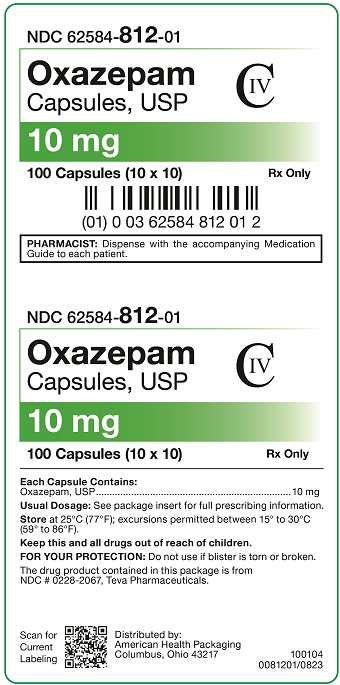
NDC 62584- 812-01
Oxazepam
Capsules, USP CIV10 mg
100 Capsules (10 x 10) Rx Only
PHARMACIST: Dispense with the accompanying Medication
Guide to each patient.Each Capsule Contains:
Oxazepam, USP........................................................................10 mgUsual Dosage: See package insert for full prescribing information.
Store at 25°C (77°F); excursions permitted between 15° to 30°C
(59° to 86°F).Keep this and all drugs out of reach of children.
FOR YOUR PROTECTION: Do not use if blister is torn or broken.
The drug product contained in this package is from
NDC # 0228-2067, Teva Pharmaceuticals.Distributed by:
American Health Packaging
Columbus, Ohio 43217100104
0081201/0823 - Package/Label Display Panel – Blister – 10 mg
-
Package/Label Display Panel – Carton – 15 mg
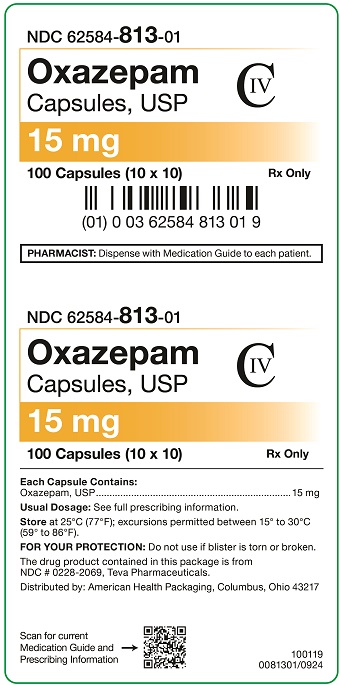
NDC 62584- 813-01
Oxazepam
Capsules, USP CIV15 mg
100 Capsules (10 x 10) Rx Only
PHARMACIST: Dispense with Medication Guide to each patient.
Each Capsule Contains:
Oxazepam, USP........................................................................15 mgUsual Dosage: See full prescribing information.
Store at 25°C (77°F); excursions permitted between 15° to 30°C
(59° to 86°F).FOR YOUR PROTECTION: Do not use if blister is torn or broken.
The drug product contained in this package is from
NDC # 0228-2069, Teva Pharmaceuticals.Distributed by: American Health Packaging, Columbus, Ohio 43217
100119
0081301/0924 - Package/Label Display Panel – Blister – 15 mg
-
Package/Label Display Panel – Carton – 30 mg

NDC 62584- 814-01
Oxazepam
Capsules, USP CIV30 mg
100 Capsules (10 x 10) Rx Only
PHARMACIST: Dispense with Medication Guide to each patient.
Each Capsule Contains:
Oxazepam, USP........................................................................30 mgUsual Dosage: See full prescribing information.
Store at 25°C (77°F); excursions permitted between 15° to 30°C
(59° to 86°F).FOR YOUR PROTECTION: Do not use if blister is torn or broken.
The drug product contained in this package is from
NDC # 0228-2073, Teva Pharmaceuticals.Distributed by: American Health Packaging, Columbus, Ohio 43217
100125
0081401/1123 - Package/Label Display Panel – Blister – 30 mg
-
INGREDIENTS AND APPEARANCE
OXAZEPAM
oxazepam capsule, gelatin coatedProduct Information Product Type HUMAN PRESCRIPTION DRUG Item Code (Source) NDC:62584-812(NDC:0228-2067) Route of Administration ORAL DEA Schedule CIV Active Ingredient/Active Moiety Ingredient Name Basis of Strength Strength OXAZEPAM (UNII: 6GOW6DWN2A) (OXAZEPAM - UNII:6GOW6DWN2A) OXAZEPAM 10 mg Inactive Ingredients Ingredient Name Strength STARCH, CORN (UNII: O8232NY3SJ) CROSCARMELLOSE SODIUM (UNII: M28OL1HH48) FD&C RED NO. 40 (UNII: WZB9127XOA) GELATIN, UNSPECIFIED (UNII: 2G86QN327L) HYPROMELLOSE 2910 (5 MPA.S) (UNII: R75537T0T4) LACTOSE MONOHYDRATE (UNII: EWQ57Q8I5X) MAGNESIUM STEARATE (UNII: 70097M6I30) METHYLPARABEN (UNII: A2I8C7HI9T) PROPYLPARABEN (UNII: Z8IX2SC1OH) SODIUM LAURYL SULFATE (UNII: 368GB5141J) TITANIUM DIOXIDE (UNII: 15FIX9V2JP) D&C RED NO. 28 (UNII: 767IP0Y5NH) D&C YELLOW NO. 10 ALUMINUM LAKE (UNII: CQ3XH3DET6) FD&C BLUE NO. 2 ALUMINUM LAKE (UNII: 4AQJ3LG584) SHELLAC (UNII: 46N107B71O) FD&C BLUE NO. 1 ALUMINUM LAKE (UNII: J9EQA3S2JM) FD&C RED NO. 40 ALUMINUM LAKE (UNII: 6T47AS764T) PROPYLENE GLYCOL (UNII: 6DC9Q167V3) FERROSOFERRIC OXIDE (UNII: XM0M87F357) Product Characteristics Color pink Score no score Shape CAPSULE Size 14mm Flavor Imprint Code R;067 Contains Packaging # Item Code Package Description Marketing Start Date Marketing End Date 1 NDC:62584-812-01 100 in 1 CARTON 12/17/2007 1 NDC:62584-812-11 1 in 1 BLISTER PACK; Type 0: Not a Combination Product 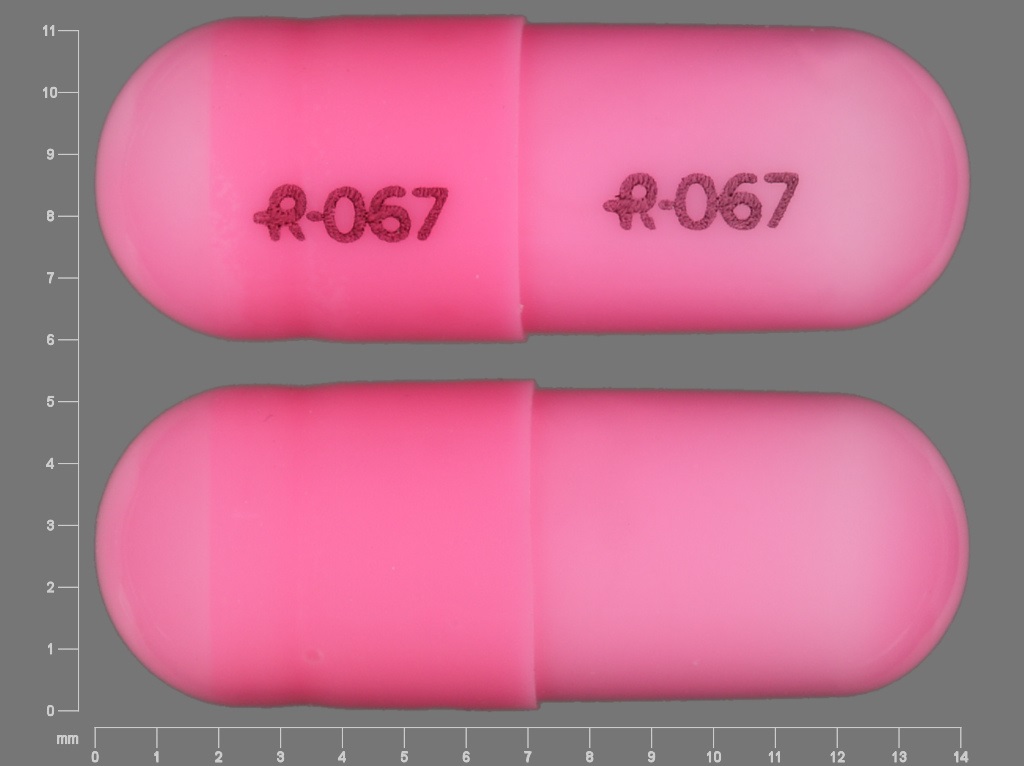
Marketing Information Marketing Category Application Number or Monograph Citation Marketing Start Date Marketing End Date ANDA ANDA072253 12/17/2007 OXAZEPAM
oxazepam capsule, gelatin coatedProduct Information Product Type HUMAN PRESCRIPTION DRUG Item Code (Source) NDC:62584-813(NDC:0228-2069) Route of Administration ORAL DEA Schedule CIV Active Ingredient/Active Moiety Ingredient Name Basis of Strength Strength OXAZEPAM (UNII: 6GOW6DWN2A) (OXAZEPAM - UNII:6GOW6DWN2A) OXAZEPAM 15 mg Inactive Ingredients Ingredient Name Strength STARCH, CORN (UNII: O8232NY3SJ) CROSCARMELLOSE SODIUM (UNII: M28OL1HH48) FD&C RED NO. 40 (UNII: WZB9127XOA) GELATIN, UNSPECIFIED (UNII: 2G86QN327L) HYPROMELLOSE 2910 (5 MPA.S) (UNII: R75537T0T4) LACTOSE MONOHYDRATE (UNII: EWQ57Q8I5X) MAGNESIUM STEARATE (UNII: 70097M6I30) METHYLPARABEN (UNII: A2I8C7HI9T) PROPYLPARABEN (UNII: Z8IX2SC1OH) SODIUM LAURYL SULFATE (UNII: 368GB5141J) TITANIUM DIOXIDE (UNII: 15FIX9V2JP) D&C YELLOW NO. 10 (UNII: 35SW5USQ3G) D&C YELLOW NO. 10 ALUMINUM LAKE (UNII: CQ3XH3DET6) FD&C BLUE NO. 1 ALUMINUM LAKE (UNII: J9EQA3S2JM) FD&C RED NO. 40 ALUMINUM LAKE (UNII: 6T47AS764T) FERROSOFERRIC OXIDE (UNII: XM0M87F357) SHELLAC (UNII: 46N107B71O) FD&C BLUE NO. 2 ALUMINUM LAKE (UNII: 4AQJ3LG584) PROPYLENE GLYCOL (UNII: 6DC9Q167V3) Product Characteristics Color red Score no score Shape CAPSULE Size 14mm Flavor Imprint Code R;069 Contains Packaging # Item Code Package Description Marketing Start Date Marketing End Date 1 NDC:62584-813-01 100 in 1 CARTON 12/17/2007 1 NDC:62584-813-11 1 in 1 BLISTER PACK; Type 0: Not a Combination Product 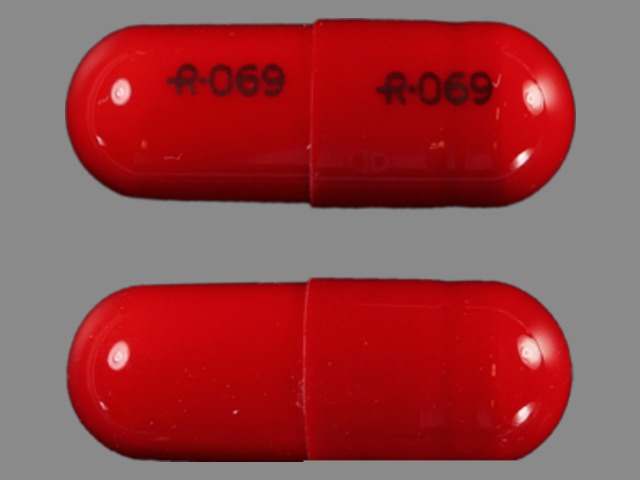
Marketing Information Marketing Category Application Number or Monograph Citation Marketing Start Date Marketing End Date ANDA ANDA072253 12/17/2007 OXAZEPAM
oxazepam capsule, gelatin coatedProduct Information Product Type HUMAN PRESCRIPTION DRUG Item Code (Source) NDC:62584-814(NDC:0228-2073) Route of Administration ORAL DEA Schedule CIV Active Ingredient/Active Moiety Ingredient Name Basis of Strength Strength OXAZEPAM (UNII: 6GOW6DWN2A) (OXAZEPAM - UNII:6GOW6DWN2A) OXAZEPAM 30 mg Inactive Ingredients Ingredient Name Strength STARCH, CORN (UNII: O8232NY3SJ) CROSCARMELLOSE SODIUM (UNII: M28OL1HH48) FD&C RED NO. 40 (UNII: WZB9127XOA) GELATIN, UNSPECIFIED (UNII: 2G86QN327L) HYPROMELLOSE 2910 (5 MPA.S) (UNII: R75537T0T4) LACTOSE MONOHYDRATE (UNII: EWQ57Q8I5X) MAGNESIUM STEARATE (UNII: 70097M6I30) METHYLPARABEN (UNII: A2I8C7HI9T) PROPYLPARABEN (UNII: Z8IX2SC1OH) SODIUM LAURYL SULFATE (UNII: 368GB5141J) TITANIUM DIOXIDE (UNII: 15FIX9V2JP) D&C RED NO. 28 (UNII: 767IP0Y5NH) FD&C BLUE NO. 1 (UNII: H3R47K3TBD) FD&C BLUE NO. 1 ALUMINUM LAKE (UNII: J9EQA3S2JM) ETHYL ACETATE (UNII: 76845O8NMZ) SHELLAC (UNII: 46N107B71O) Product Characteristics Color brown Score no score Shape CAPSULE Size 14mm Flavor Imprint Code R;073 Contains Packaging # Item Code Package Description Marketing Start Date Marketing End Date 1 NDC:62584-814-01 100 in 1 CARTON 12/17/2007 1 NDC:62584-814-11 1 in 1 BLISTER PACK; Type 0: Not a Combination Product 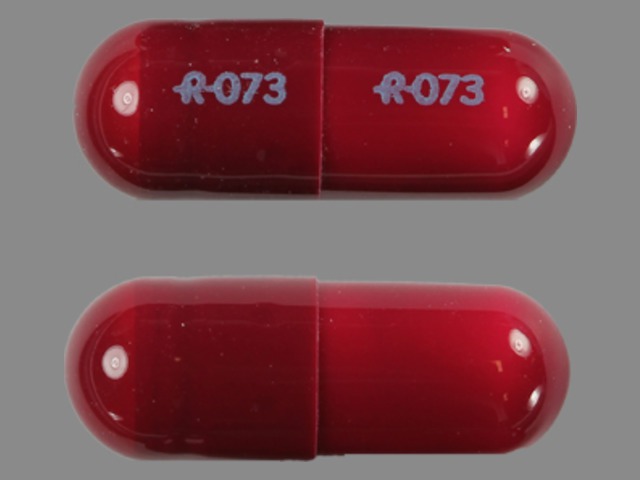
Marketing Information Marketing Category Application Number or Monograph Citation Marketing Start Date Marketing End Date ANDA ANDA072253 12/17/2007 Labeler - American Health Packaging (929561009) Establishment Name Address ID/FEI Business Operations American Health Packaging 929561009 repack(62584-813, 62584-814, 62584-812)


